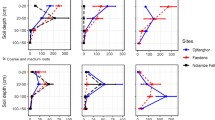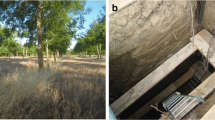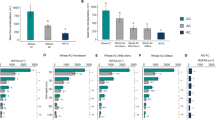Abstract
A major constrait to alley cropping is the competition of tree or shrub roots with those of companion food crops for available water and nutrients in the topsoil. Root distribution patterns of Acioa barteri, Alchornea cordifolia, Cassia siamea and Gmelina arborea grown on an acid Ultisol at Onne in the humid forest zone of southeastern Nigeria were examined to a depth of 120 cm and laterally to 200 cm from the tree trunk to study the suitability of the species for alley cropping. The four woody species have roots throughout the soil profile examined but differ in the concentration of roots both laterally and vertically. Alchornea cordifolia, Cassia siamea and Gmelina arborea, in spite of higher underground biomass production, most of their fine roots (<2 mm diameter) were in the top 20 cm of the soil. This soil layer had 73%, 76%, and 74% of the total Alchornea cordifolia, Cassia siamea, and Gmelina arborea fine roots in the profile examined, respectively. Such root systems would compete with food crops for nutrients and moisture in the surface soil. Alchornea cordifolia and Gmelina arborea have many large woody roots in the surface soil which will make any tillage operation or seedbed preparation difficult. Acioa barteri in contrast, has the desirable rooting system with fewer fine roots in the surface soil (49%), and roots that are concentrated close to tree trunk and decrease markedly away from the tree base. In addition, Acioa barteri roots penetrate deeper soil horizons and can result in more efficient nutrient cycling from these layers, and reduced competition with shallow-rooted food crops. The rooting distribution patterns of Acioa barteri indicated that the species is a promising alley shrub in acid soils of the humid forest ecology. Therefore, consideration of rooting characteristics of potential tree/shrub species is recommended for the development of agroforestry systems such as alley cropping.
Similar content being viewed by others
References
Ball B (1985) Root distribution and nutrient cycling of some table tree-shrubs suitable for alley cropping in the humid tropics, pp 35–59 Unpublished M. Sc. thesis. University of Guelph, Canada
Bohm W (1979) Methods of Studying Root Systems. Springer-Verlag, Berlin
Bowen GD (1984) Tree roots and the use of soil nutrients. In: Bowen GD and Nambiar EKS, eds, Nutrition of Plantation Forests, pp 148–179. Academic press, London
Bowen GD (1985) Roots as a component of tree productivity. In: Cannel MGR and Jackson JE, eds, Trees as Crop Plants, pp 303–315. Inst. Terrestrial Ecology Huntingdon, England
de Willigen P and van Noordwijk M (1987) Roots, plant production and nutrient use efficiency. Ph. D. thesis, Agricultural University Wageningen, The Netherlands, pp 244–248
Gichuru M and Kang BT (1990) Potential woody species for alley cropping on acid soils. pp 85–87. In: Moore E, (ed), Agroforestry, Land-Use Systems. Proceeding of a special session of American Society of Agronomy Annual Meeting, Nov, 28–29, 1988, Anaheim, California,NFTA, Funny Press, Bangkok, Thailand
Gichuru MP, Kang BT and Hauser S (1990). Alley cropping with Acioa barteri, Cassia siamea, Flemingia macrophylla and Gmelina arborea on an acid Ultisol. Paper presented at the American Society of Agronomy Annual Meeting, San Antonio, Texas, USA, October 21–26, 1990. Agron. Abstr., p 57
Hairiah K and van Noordwijk M (1986) Root studies on a tropical Ultisol in relation to nitrogen management. Report 7–86. Instituut voor Bodemvruchtbaarheid, Haren (GR.), The Netherlands, 121 pp
Hulugalle NR, Lal R and Gichuru M (1989) Effect of five years of no-tillage and mulch on soil properties and tuber yield of cassava on an acid Ultisol in southeastern Nigeria. Expl Agric 26: 235–240
Kang BT, Reynolds L and Atta-Krah K (1990) Alley farming. Adv Agron 43: 315–358
Kang BT, van der Kruijs ACBM and Couper DC (1989) Alley cropping for food crop production in the humid and subhumid tropics In: Kang BT and Reynolds L, eds, Alley Farming in the Humid and Subhumid Tropics, pp 16–26. Workshop held at Ibadan, Nigeria, 10–14 March, 1986, IDRC, Ottawa, Canada
Keay RWJ, Onochie CF and Stanfield DP (1964) Nigerian trees. Fed Dept of For Res; Ibadan, Nigeria, Vol 1, pp249–322, Vol 2, pp 67–431
Kolesnikov V (1971) The Root System Fruit Plants. Mir Publishers, Moscow, pp 82–206
Lundgren B (1979) Research strategy for soils in Agroforestry. In: Mongi H and Huxley P, eds, Soil Research in Agroforestry, pp 523–538. Proceedings of an expert consultation, ICRAF, Nairobi, Kenya
MacDicken KG and Vergara NT (1990) Agroforestry: Classification and Management. John Wiley & Sons, New York, pp 1–30
Sanchez PA (1976) Properties and Management of Soils in the Tropics. John Wiley & Sons, New York, pp 346–412
SAS (1988) Statistical Analysis System (SAS), Procedures guidi, Release 6.03 Edition. SAS Institute Inc, Cary, N.C. USA
Tennant D (1975) A test of a modified line intersect method of estimating root lenght. JEEcol 63: 998–1001
Author information
Authors and Affiliations
Additional information
IITA Journal Paper No: 91:/JA/24.
Rights and permissions
About this article
Cite this article
Ruhigwa, B.A., Gichuru, M.P., Mambani, B. et al. Root distribution of Acioa barteri, Alchornea cordifolia, Cassia siamea and Gmelina arborea in an acid Ultisol. Agroforest Syst 19, 67–78 (1992). https://doi.org/10.1007/BF00130095
Issue Date:
DOI: https://doi.org/10.1007/BF00130095




